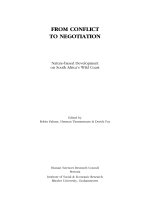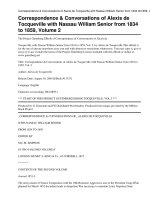- Trang chủ >>
- Luật >>
- Luật dân sự
From beirut to jerusalem
Bạn đang xem bản rút gọn của tài liệu. Xem và tải ngay bản đầy đủ của tài liệu tại đây (7.89 MB, 543 trang )
Tai Lieu Chat Luong
$22.95
In From Beirut to Jerusalem, Thomas L.
Friedman of The New York Times has drawn
on his decade in the Middle East to produce the most trenchant, vivid, and thoughtprovoking book yet on the region.
No issue in international politics has been
more hotly debated than the Arab-Israeli
conflict. No part of the world has consistently made more headlines during the past
forty years than the Middle East. And no
reporter has illuminated both the ArabIsraeli conflict and the rhythms of Ufe in the
Middle East with more immediacy and brilliance than Tom Friedman, twice winner of
the Pulitzer Prize for international reporting—once for his coverage of Lebanon and
a second time for his work in Israel.
Friedman is a master of the sharp anecdote and the telling detail that sum up a
world of ideas in microcosm. He describes
with intense vividness what it's like to live
in a city gone mad like Beirut; he leads us
on an unforgettable journey into the inner
circle of Arab regimes to show how the game
of Arab politics is really played; he examines
the intifada and Israeli-Palestinian relations,
the PLO, Israeli politics, the Lebanese factions, news reporting from the Middle East,
and America's difficulty in understanding
them. Extremism, terrorism, fundamentalism on right and left—Friedman puts all the
operative currents into perspective with an
inimitable specificity and clarity.
Each chapter is a stop on Friedman's own
remarkable journey from Beirut to Jerusalem—a journey which he brings alive
through anecdote, history, analysis, and autobiography. His book, he writes, "is about
a young man from Minnesota who goes to
Beirut and confronts a world for which nothing in his life had prepared him, a student
of Middle East politics who discovers that
the region bears little resemblance to the
logical and antiseptic descriptions he found
in most of his textbooks. It is about a Jew
raised on all the myths about Israel who discovers that it isn't the summer camp of his
youth but an audacious and still unresolved
experiment to get Jews to live together in
the midst of the Arab world. Lastly, it is a
(continued on back flap)
(continued from front flap)
book about the people in Beirut and Jerusalem themselves, who, I discovered, were
going through remarkably similar identity
crises. Each was caught in a struggle between
the new ideas, the new relationships, the
new nations they were trying to build for the
future, and the ancient memories, ancient
passions, and ancient feuds that kept dragging them back into the past."
From Beirut to Jerusalem is a major work
of reportage, a much needed framework for
understanding the Middle East—yesterday,
today, and tomorrow.
THOMAS L .
F R I E D M A N was boni in
Minneapolis in 1953. He graduated from
Brandeis University and held a Marshall
Scholarship at St. Antony's College, Oxford, earning an M.Phil, in Modern Middle
East Studies in 1978.
From 1979 to 1981, Mr. Friedman was
UPI's Beirut correspondent. In 1982, he became the New York Times Beirut bureau
chief, winning a 1983 Pulitzer Prize for his
coverage of the Israeli invasion of Lebanon.
In 1984, he moved to Jerusalem as the Times
bureau chief, and in 1988 won a second Pulitzer Prize for reporting. He became the
Times chief diplomatic correspondent, covering the State Department and foreign affairs, in January 1989.
Mr. Friedman's honors include the Overseas Press Club Award (1980), the George
Polk Award (1982), the Livingston Award
for Young Journalists (1982), the New York
Newspaper Guild Page One Award (1984),
and the New Israel Fund Award for Outstanding Reporting from Israel (1987). He
was awarded a Guggenheim Fellowship for
his work on this book. He lives in Washington with his wife, Ann,- and daughters Orly
and Natalie.
Jacket design © 1989 by David Gatti
Author photo © 1989 by Jerry Bauer
Farrar, Straus and Giroux
19 Union Square West
New York 10003
0-374-15894-0
789
FROM
BEIRUT
TO
JERUSALEM
JTJTnjTJTJTJTnjTJTJTJTnjTJTriTL
FROM
BEIRUT
TO
JERUSALEM
Thomas L Friedman
FARRAR
STRAUS
New York
GIROUX
Copyright © 1989 by Thomas L. Friedman
ALL
RIGHTS RESERVED
Printed in the United States of America
Published simultaneously in Canada by
Collins Publishers, Toronto
FIRST EDITION,
1989
Fourth printing, 1989
Library of Congress catalog card number: 89-45583
Grateful acknowledgment is made to the following for permission to reprint previously
published material:
Excerpt from Waiting for Godot by Samuel Beckett, copyright © 1954 by Grove Press
Inc., renewed 1982 by Samuel Beckett.
Excerpts from the "PLAYBOY interview: Yasir Arafat," PLAYBOY magazine (September
1988), copyright © 1988 by PLAYBOY. Reprinted with permission. All rights reserved.
Interview conducted by Morgan Strong.
For my parents,
Harold and Margaret Friedman
"Did you want to kill him, Buck?"
"Well, I bet I did."
"What did he do to you?"
"Him? He never done nothing to me."
"Well, then, what did you want to kill him for?"
"Why, nothing—only it's on account of the feud."
"What's a feud?"
"Why, where was you raised? Don't you know what a feud is?"
"Never heard of it before—tell me about it."
"Well," says Buck, "a feud is this way: A man has a quarrel
with another man, and kills him; then that other man's brother
kills him; then the other brothers, on both sides, goes for one
another; then the cousins chip in—and by and by everybody's
killed off, and there ain't no more feud. But it's kind of slow,
and takes a long time."
"Has this one been going on long, Buck?"
"Well, I should reckon}. It started thirty years ago, or som'ers
along there. There was trouble 'bout something, and then a lawsuit to settle it; and the suit went agin one of the men, and so he
up and shot the man that won the suit—which he would naturally
do, of course. Anybody would."
"What was the trouble about, Buck?—land?"
"I reckon maybe—I don't know."
"Well, who done the shooting? Was it a Grangerford or a
Shepherdson?"
"Laws, how do I know? It was so long ago."
"Don't anybody know?"
" Oh, yes, pa knows, I reckon, and some of the other old people ;
but they don't know now what the row was about in the first
place."
—Mark Twain, The
Adventures of Huckleberry
Finn
Contents
A Middle East Chronology
i Prelude: From Minneapolis to Beirut
xi
3
BEIRUT
2 Would You Like to Eat Now or Wait for the
Cease-fire?
3 Beirut: City of Versions
4 Hama Rules
5 The Teflon Guerrilla
6 Inside the Kaleidoscope: The Israeli Invasion
of Lebanon
7 Poker, Beirut-Style
8 Betty Crocker in Dante's Inferno
9 The End of Something
io Time to Go
21
49
76
io6
126
156
187
212
243
JERUSALEM
//
12
13
14
75
Crosswinds
Whose Country Is This, Anyway?
The Fault Line
The Earthquake
Under the Spotlight
251
284
322
366
425
Contents
X
i6 Israel and American Jews: Who Is Dreaming
about Whom?
1J Conclusion: From Beirut to Jerusalem to
Washington
451
491
ACKNOWLEDGMENTS
510
INDEX
515
A Middle East Chronology
1882 As a result of the persecution of Jews in Russia and Romania a year earlier, the first large-scale immigration of Jewish
settlers to Palestine takes place.
1891 Arab notables in Jerusalem send a petition to the Ottoman
government in Constantinople demanding the prohibition of Jewish immigration to Palestine and Jewish land purchases.
1896 Austrian journalist Theodor Herzl, the founder of modern
Zionism, publishes his pamphlet The Jewish State, which argues
that the "Jewish Problem" can be solved only by setting up a
Jewish state in Palestine, or somewhere else, so that Jews can
live freely without fear of persecution. A year later, Herzl organizes the first Zionist Congress in Basel, Switzerland, to promote immigration to Palestine.
1908 The first Palestinian Arabic newspapers appear: Al-Quds,
in Jerusalem and Al-Asma'i in Jaffa.
1916 The Sykes-Picot Agreement is forged by Britain, France,
and Russia, carving up the Ottoman Empire after its defeat in
World War I. As part of the agreement, Britain wins effective
control over the area of Palestine, and France over the area that
is now Lebanon and Syria.
1917 The Balfour Declaration is issued by British Foreign Secretary Arthur J. Balfour, endorsing the idea of establishing a
"national home" for the Jewish people in Palestine.
1920 France decrees the formation of the state of Greater Lebanon, knitting together Mt. Lebanon with the regions of Beirut,
Tripoli, Sidon, Tyre, Akkar, and the Bekaa Valley.
XU
A Middle East Chronology
1936-39 Inspired by other Arab nationalist movements, the
Arabs of Palestine revolt in an attempt to halt the establishment
of a Jewish homeland in Palestine. Both Jewish settlements and
British army units come under attack.
1943 Lebanon's Christian and Muslim leaders agree on a "National Pact" for sharing power and balancing Lebanon's Western
and Arab orientations, enabling their country to become a state
independent of France.
1947 The United Nations votes to partition Palestine into two
states, one for the Jews and one for the Palestinian Arabs, with
Jerusalem to become an international enclave.
1948 Britain withdraws from Palestine. Instead of implementing
the UN partition plan, the surrounding Arab states join with the
local Palestinians to try to prevent the emergence of a Jewish
state. Israel is established anyway; Jordan occupies the West Bank
and Egypt the Gaza Strip.
1956 Israel, joining forces with Britain and France to attack
Gamal Abdel Nasser's Egypt, occupies most of the Sinai Peninsula. Under pressure from both the United States and the Soviet
Union, Israel later withdraws.
1958 ThefirstLebanese civil war erupts and some 15,000 American troops are sent to Beirut to help stabilize the situation.
1964 Arab heads of state led by Nasser establish the Palestine
Liberation Organization (PLO) in Cairo.
1967 Israel launches a preemptive strike against Egypt, Syria,
and Jordan as they are preparing for war against the Jewish state.
The Six-Day War ends with Israel occupying the Sinai Peninsula,
the Golan Heights, the Gaza Strip, and the West Bank.
1969 Yasir Arafat, leader of the al-Fatah guerrilla organization,
is elected chairman of the executive committee of the PLO.
A Middle East Chronology
xiu
1970 King Hussein's army defeats Arafat's PLO guerrillas in a
civil war for control of Jordan.
1973 Egypt and Syria launch a surprise attack against Israeli
forces occupying the Sinai Peninsula and the Golan Heights.
1974 An Arab summit conference in Rabat, Morocco, affirms
that the PLO is the "sole and legitimate representative" of the
Palestinian people.
1975 Civil war breaks out again in Lebanon.
1977 Egyptian President Anwar Sadat goes to Jerusalem, addresses the Israeli parliament, and offers full peace in exchange
for a total Israeli withdrawal from Sinai.
1979 Egypt and Israel sign their peace treaty.
1982—February The Syrian government massacres thousands
of its own citizens while suppressing a Muslim rebellion launched
from the town of Hama.
1982—June to September Israel invades Lebanon. Phalangist
militia leader Bashir Gemayel is assassinated after his election as
Lebanon's President. Phalangist militiamen massacre hundreds
of Palestinians in the Sabra and Shatila refugee camps in Beirut,
while the camps are surrounded by Israeli forces. U.S. Marines
arrive in Beirut as part of a multinational peacekeeping force.
1983 The American embassy and U.S. Marine headquarters in
Beirut are blown up by suicide car bombers.
1984—February The Lebanese government of President Amin
Gemayel splinters after Shiite Muslims and Druse in West Beirut
launch a revolt against the Lebanese army. President Reagan
abandons hope of rebuilding Lebanon and orders Marines home.
1984—September Israel's Labor and Likud Parties join together
in a national unity government after July elections end in a
stalemate.
XIV
A Middle East Chronology
1985 Israel unilaterally withdraws its army from most of
Lebanon.
1987—December The Palestinian uprising, or intifada, begins in
the West Bank and Gaza Strip.
1988—December Arafat recognizes Israel's right to exist. U.S.
Secretary of State George P. Shultz authorizes the opening of a
dialogue with the PLO. Likud and Labor join together to form
another national unity government in Israel after another stalemated election.
FROM
BEIRUT
TO
JERUSALEM
1
Prelude: From
Minneapolis to Beirut
In June 1979, my wife, Ann, and I boarded a red-and-white Middle East Airlines 707 in Geneva for the four-hourflightto Beirut.
It was the start of the nearly ten-year journey through the Middle
East that is the subject of this book. It began, as it ended, with
a bang.
When we got in line to walk through the metal detector at our
boarding gate, we found ourselves standing behind three broadshouldered, mustachioed Lebanese men. As each stepped
through the metal detector, it would erupt with a buzz and a
flashing red light, like a pinball machine about to tilt. The Swiss
police immediately swooped in to inspect our fellow passengers,
who turned out not to be hijackers bearing guns and knives,
although they were carrying plenty of metal; they were an Armenian family of jewelers bringing bricks of gold back to Beirut.
Each of the boys in the family had a speciallyfittedmoney belt
containing six gold bars strapped around his stomach, and one of
them also had a shoe boxfilledwith the precious metal. They sat
4
Prelude: From Minneapolis to Beirut
next to Ann and me in the back of the plane and spent part of
the flight tossing the gold bricks back and forth for fun.
When our MEA plane finally touched down at Beirut International Airport, and I beheld the arrival terminal's broken windows, bullet scars, and roaming armed guards, my knees began
to buckle from fear. I realized immediately that although I had
spent years preparing for this moment—becoming a foreign correspondent in the Middle East—nothing had really prepared me
for the road which lay ahead.
In Minneapolis, Minnesota, where I was born and raised, I had
never sat next to people who tossed gold bricks to each other in
the economy section on Northwest Airlines. My family was, I
suppose, a rather typical middle-class American Jewish family.
My father sold ball bearings and my mother was a homemaker
and part-time bookkeeper. I was sent to Hebrew schoolfivedays
a week as a young boy, but after I had my bar mitzvah at age
thirteen, the synagogue interested me little; I was a three-day-ayear Jew—twice on the New Year (Rosh Hashanah) and once on
the Day of Atonement (Yom Kippur). In 1968, my oldest sister,
Shelley, spent her junior year abroad at Tel Aviv University; it
was the year after Israel's dramatic victory in the Six-Day War—
a time when Israel was very much the "in" place for young American Jews. Over the Christmas break of 1968 my parents took me
to Israel to visit my sister.
That trip would change my life. I was onlyfifteenyears old at
the time and just waking up to the world. Theflightto Jerusalem
marked the first time I had traveled beyond the border of Wisconsin and thefirsttime I had ridden on an airplane. I don't know
if it was just the shock of the new, or a fascination waiting to be
discovered, but something about Israel and the Middle East
grabbed me in both heart and mind. I was totally taken with the
place, its peoples and its conflicts. Since that moment, I have
never really been interested in anything else. Indeed, from the
first day I walked through the walled Old City of Jerusalem,
inhaled its spices, and lost myself in the multicolored river of
humanity thatflowedthrough its maze of alleyways, I felt at home.
Surely, in some previous incarnation, I must have been a bazaar
merchant, a Frankish soldier perhaps, a pasha, or at least a medieval Jewish chronicler. It may have been my first trip abroad,
Prelude: From Minneapolis to Beirut
5
but in 1968 I knew then and there that I was really more Middle
East than Minnesota.
When I returned home, I began to read everything I could get
my hands on about Israel. That same year, Israel's Jewish Agency
sent a shaliach, a sort of roving ambassador and recruiter, to
Minneapolis for the first time. I became one of his most active
devotees—organizing everything from Israeli fairs to demonstrations. He arranged for me to spend all three summers of high
school living on Kibbutz Hahotrim, an Israeli collective farm on
the coast just south of Haifa. For my independent study project
in my senior year of high school, in 1971, I did a slide show on
how Israel won the Six-Day War. For my high-school psychology
class, my friend Ken Greer and I did a slide show on kibbutz life,
which ended with a stirring rendition of "Jerusalem of Gold" and
a rapid-fire montage of strong-eyed, idealistic-looking Israelis of
all ages. In fact, high school for me, I am now embarrassed to
say, was one big celebration of Israel's victory in the Six-Day
War. In the period of a year, I went from being a nebbish whose
dream was to one day become a professional golfer to being an
Israel expert-in-training.
I was insufferable. When the Syrians arrested thirteen Jews in
Damascus, I wore a button for weeks that said Free the Damascus
13, which most of my high-school classmates thought referred to
an underground offshoot of the Chicago 7. I recall my mother
saying to me gently, "Is that really necessary?" when I put the
button on one Sunday morning to wear to our country-club
brunch. I became so knowledgeable about the military geography
of the Middle East that when my high-school geography class had
a teaching intern from the University of Minnesota for a month,
he got so tired of my correcting him that he asked me to give the
talk about the Golan Heights and the Sinai Peninsula while he
sat at my desk. In 1968, the first story I wrote as a journalist for
my high-school newspaper was about a lecture given at the University of Minnesota by a then-obscure Israeli general who had
played an important role in the 1967 war. His name was Ariel
Sharon.
During the summer that I spent in Israel after high-school graduation, I got to know some Israeli Arabs from Nazareth, and our
chance encounter inspired me to buy an Arabic phrase book and
6
Prelude: From Minneapolis to Beirut
to begin reading about the Arab world in general. From my first
day in college, I started taking courses in Arabic language and
literature. In 1972, my sophomore year, I spent two weeks in
Cairo on my way to Jerusalem for a semester abroad at the Hebrew University. Cairo was crowded, filthy, exotic, impossible—
and I loved it. I loved the pita bread one could buy hot out of
the oven, I loved the easy way Egyptians smiled, I loved the
mosques and minarets that gave Cairo's skyline its distinctive
profile, and I even loved my caddy at the Gezira Sporting Club,
who offered to sell me both golf balls and hashish, and was ready
to bet any amount of money that I could not break 40 my first
time around the course. (Had two racehorses not strolled across
the ninth fairway in the middle of my drive, I might have won
the bet.)
In the summer of 1974, between my junior and senior years of
college, I returned to Egypt for a semester of Arabic-language
courses at the American University in Cairo. When I came back
to Brandeis, where I was studying for my B.A., I gave a slide
lecture about Egypt. An Israeli graduate student in the audience
heckled me the entire time asking, ''What is a Jew doing going
to Egypt?" and "How dare you like these people?" Worse, he
got me extremelyflusteredand turned my talk into a catastrophe
I would never forget. But I learned two important lessons from
the encounter. First, when it comes to discussing the Middle East,
people go temporarily insane, so if you are planning to talk to an
audience of more than two, you'd better have mastered the subject. Second, a Jew who wants to make a career working in or
studying about the Middle East will always be a lonely man: he
will never be fully accepted or trusted by the Arabs, and he will
never be fully accepted or trusted by the Jews.
After graduating from Brandeis in 1975,1 decided to study with
the masters of Middle Eastern Studies—the British. I enrolled at
St. Antony's College, Oxford University, where I took a master's
degree in the history and politics of the modern Middle East. St.
Antony's was everything I had hoped for by way of formal education, but I learned as much in the dining room as in the classroom. As the center of Middle Eastern studies in England, St.
Antony's attracted the very best students from the Arab world
and Israel. Since there were only about 125 students in the college
and we ate three meals a day together, we got to know each other
Prelude: From Minneapolis to Beirut
y
very well. At Brandeis, I was considered knowledgeable about
the Middle East, but among the St. Antony's crowd I was a
complete novice. I learned to be a good listener, though, and
there was plenty to listen to.
My years at St. Antony's coincided with the start of the Lebanese civil war. I shared a bathroom with an extremely bright
Lebanese Shiite, Mohammed Mattar, and a lunch table with Lebanese Christians and Palestinians; my closest friend at St. Antony's was an Iraqi Jew, Yosef Sassoon, whom I had met, along
with his wife, Taffy, in the laundry room. Watching them all
interact, argue, challenge each other at lectures, and snipe at one
another at mealtimes taught me how much more there was to the
Middle East than Arab versus Jew. A spectator of their feuds,
an outsider, I managed to stay on friendly terms with all of them,
as well as with the Israelis on campus.
While studying in England, I began my career in journalism.
One day in August 1976, I was walking down a street in London
and noticed a headline from the London Evening Standard which
read: CARTER TO JEWS: IF ELECTED I'LL FIRE DR. K. The article
was about how candidate Jimmy Carter was promising to dismiss
Secretary of State Henry Kissinger if elected President. How odd,
I thought to myself, that a presidential candidate could curry favor
among American Jews by promising to fire the first-ever Jewish
Secretary of State. I decided to write an Op Ed article explaining
this anomaly. My girlfriend and future wife, Ann Bucksbaum,
happened to be friendly with the editorial-page editor of the Des
Moines Register, Gilbert Cranberg. Ann brought him the article.
He liked it and printed it on August 23, 1976; thus did Ifindmy
calling as a Middle East correspondent. Over the next two years,
I wrote more such articles, and upon graduation from St. Antony's
I had a small portfolio of Op Ed pieces to show for myself.
Shortly before graduating from Oxford in June 1978, I applied
for a job with the London bureau of United Press International.
I had decided that the academic ivory tower was not for me and
that if I was ever going to be able to hold my own on the Middle
East, I had to live there and experience the placefirsthand.Fortunately, Leon Daniel, the UPI bureau chief in London, was ready
to take a chance on me—despite the fact that I had never so
much as covered a one-alarmfire—andgave me a job as a starting
reporter. I was so nervous myfirstweek that I kept getting bloody









